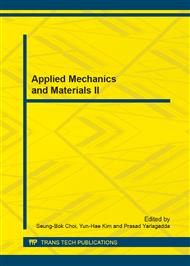[1]
Wang G Q, Hapuarachchi P, Ishidaira H, Kiem A, Takeuchi K, Estimation of soil erosion and sediment yield during individual rainstorms at catchment scale. Water Resources Management, 23(8), pp.1447-1465, (2009).
DOI: 10.1007/s11269-008-9335-8
Google Scholar
[2]
Wang G Q, Yu J S, Threstha S, Ishidaira H, Takeuchi K, Application of a distributed erosion model for the assessment of spatial erosion patterns in the Lushi catchment. China. Environmental Earth Science, 61, pp.787-797, (2010).
DOI: 10.1007/s12665-009-0391-z
Google Scholar
[3]
Wang G Q, Hapuarachchi P, Ishidaira H, Kiem A, Takeuchi K, Grid based distributed model for simulating runoff and soil erosion from a large-scale river basin. Hydrological Processes, 24(5), pp.641-653, (2010).
DOI: 10.1002/hyp.7558
Google Scholar
[4]
Wu BB, Wang GQ, Xu ZX, Liu CM, Modeling impacts of highly regulated inflow on themal regime and water age in a shallow reservoir. Journal of Hydroinformatics, 15(4), pp.1312-1325, (2013).
DOI: 10.2166/hydro.2013.178
Google Scholar
[5]
D. Cassie, The thermal regime of rivers: a review. Freshwater Biol, 51, p.1389–1406, (2006).
Google Scholar
[6]
Wang G Q, Yu J S, Threstha S, Ishidaira H, Takeuchi K, Application of a distributed erosion model for the assessment of spatial erosion patterns in the Lushi catchment, China. Environmental Earth Science, 61, pp.787-797, (2010).
DOI: 10.1007/s12665-009-0391-z
Google Scholar
[7]
J. Berntsen, Internal pressure errors in sigma-coordinate ocean models. J. Atmos. Oceanic Technol, 19, p.1403–1414, (2002).
DOI: 10.1175/1520-0426(2002)019<1403:ipeisc>2.0.co;2
Google Scholar
[8]
Wang G Q, Xu Z X, Assessment on the function of reservoirs for flood control during typhoon seasons based on a distributed hydrological model. Hydrological Processes, 25, pp.2506-2517, (2011).
DOI: 10.1002/hyp.8023
Google Scholar
[9]
Wang GQ, Xu ZX, Evaluating the Impact of Land Use Changes on Soil Erosion and Sediment Yield Using a Grid-based Distributed Modelling Approach. Hydrological Processes, 26, pp.3579-3592, (2012).
DOI: 10.1002/hyp.9193
Google Scholar
[10]
Wang GQ, Yang HC, Wang LJ, Xu ZX, Xue BL, Using the SWAT model to assess impacts of land use changes on runoff generation in headwaters. Hydrological Processes, DOI: 10. 1002/hyp. 9645.
DOI: 10.1002/hyp.9645
Google Scholar
[11]
Wang GQ, A YL, Xu ZX, Zhang SR. The influence of land use patterns on water quality at multiple spatial scales in a river system. Hydrological Processes, doi: 10. 1002/hyp. 10017.
DOI: 10.1002/hyp.10017
Google Scholar


